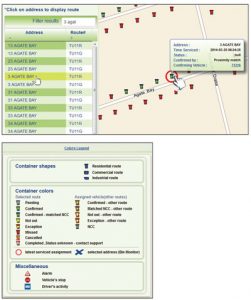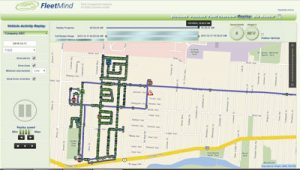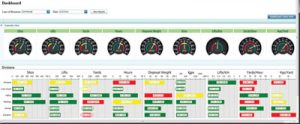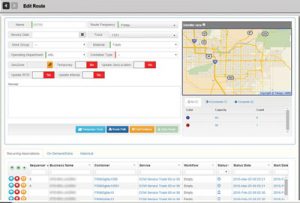An effective route management solution is like having a “supervisor in every truck”. With rapidly evolving route management technologies, this hands-on level of monitoring and verification is now a reality.
By Martin Demers
We speak with waste and recycling fleet managers from all across North America on a daily basis. They care about a lot of things, but managing their routes and drivers for maximum efficiencies tops their list of concerns most consistently. With cost pressures increasing, fleet managers are constantly tasked to get more productivity from their drivers and trucks to improve operational margins, meet environmental targets and keep customers happy. Beyond route optimization software, they want greater visibility and a more encompassing approach for practical, ‘on-the-street’ route management toward making sure drivers are executing their routes and activities exactly according to plan.
These concerns correlate to a growing global demand. Research firm markets and market forecasts show that the global fleet management market is estimated to grow from USD 8.03 Billion in 2015 to USD 22.35 Billion by 2020, at a Compound Annual Growth Rate (CAGR) of 22.7 percent for the forecast period—a whopping increase. This market is being driven primarily by accelerating global concerns about the environment and an increasing need for operational efficiencies in the fleet sector. Specifically, these concerns are derived from a desire to reduce the costs and risks related to vehicle management, and to minimize carbon emissions by better monitoring drivers, fuel and routes.
What is Route Management?
Route management is the governing practice of achieving the best efficiencies from fleet operations. Route management can encompass route optimization software as part of an overall solution; however, getting the best performance from trucks and drivers requires an understanding of how to make efficiencies work at the street level. Route management takes the theory of optimizing route efficiencies and combines that with the real-time fleet tracking, digital video recording (DVR) monitoring, turn-by-turn driver direction and more, to ensure that vehicles actually use those routes that minimize the distance, the amount of fuel used or the amount of time required to fulfill their duties. Route management should also include the ability to track carts and containers, and monitoring driver behavior and truck activity to ensure safer driving and more precise service verification.
What are the Potential Savings/Benefits?
Route and fleet management solutions are proven to reduce fuel consumption with more efficient routing and by the monitoring of vehicles and drivers to ensure that the plans are followed. The savings can be huge. ABI Research cites such benefits as more than 12 percent increases in service profitability, 13 percent improvements in vehicle use, and nearly 15 percent decreases in travel time with fleet and route management solutions. In addition, the benefits of improved fleet safety practices can be significant in terms of reduced insurance premiums, less downtime due to accidents, and reduced risk of associated legal costs. When you multiply these numbers across your fleet—the savings are considerable.
What Should a Route Management Solution Entail?
Effective and complete route management solutions should consider the following capabilities.
Route Management Systems
Route Management Systems (RMS) are usually Web portals that provide tools for planning and executing collection services activity, billing (including the identification of extras) and customer services issues resolution. They typically include features for: the management and tracking of cart inventory, the creation, management and dispatching of routes, the dynamic dispatching of on-demand services, the tracking of driver activities including disposals, and the tracking and documentation of incidents and management of customer complaints or requests. Fleet managers can use RMS for things like centralizing all operations data, scheduling recurring and on-demand services, generating service reports, overseeing cart and fleet maintenance, and more. Benefits include more efficient route scheduling, real-time service quality monitoring, more accurate billing and greater transparency across fleet operations.
Multi-Faceted Driver Displays
Onboard computing displays typically offer real-time information to drivers and dispatchers about a truck’s load weight, route status, service completion, vehicular telemetry, driver activities and much more. These displays should be able to manage a wide range of inputs from a vehicle’s onboard systems including cameras, scales, RFID readers, tire pressure and fuel monitoring, as well as other devices. Further, driver displays need to be rugged enough to withstand the harsh waste collection environments, and be user-friendly enough to minimize the interactions required from the driver during normal operation. In a well-designed system, drivers should only be asked to interact with the system to manage exceptions.
Route Optimization Software
Standard route optimization software can typically calculate the most efficient means of servicing a list of customers based on a number of parameters such as time constraints, weight per customer/load, turning right only and so forth. These systems use geographic information system-based (GIS) modeling software for routing and analytics. They can also balance multiple data inputs such as route times and service days to model optimized route travel time. They do, however, also have limitations when not all relevant data is readily available or when the service location is not on a street-front address (for example, alley pick-ups or commercial/roll-off containers placed behind buildings or far off the road). Other techniques, such as sequencing based on an actual breadcrumb of a route or timestamp of an actual list of pickups, can also achieve a good level of optimization. This approach, coupled with the ability of an effective mobile platform to dynamically re-sequence a route based on proximity of customers, will deliver optimal routing outcomes.
Fleet Monitoring
Fleet monitoring solutions track vehicles, drivers and their activities with the precise geo-coding (GPS) of all data and events. This allows the fleet manager to determine how vehicles are being handled, how the routes are being run and how the drivers behave. Exceptional situations are communicated in real-time with the use of alarms that document each event including the vehicle’s position, speed, direction and service context. More advanced systems will be able to compare the vehicle’s speed against the posted limits, identify when the vehicle goes off-route, track service exceptions including unauthorized service events, track mechanical issues by monitoring the vehicle’s Electronic Control Module and more. Fleet monitoring, together with driver behavior monitoring capabilities, will further allow the fleet manager to identify coaching opportunities and influence safer and more efficient driving habits.
Fleet Tracking
Fleet tracking typically involves a Web portal presenting a real-time view of fleet vehicles’ positions over a map. More comprehensive solutions will allow you to plot historical breadcrumbs and present route data with the status of every stop. They will also allow you to replay the breadcrumb and route for analysis. Layers can be added to show driver activities such as lunch, breaks, disposals and so forth, as well as alarms or other exceptional situations such as incidents, video recordings and photos documenting exceptions. The fleet tracking system can typically present the route’s geo-zone so that you can easily determine what occurs inside or outside the route, as well as ingress and egress times. For route optimization, multiple breadcrumb trails can be presented simultaneously, thereby allowing the fleet manager to visually see any overlap in a group of routes so that the stops can be re-arranged to minimize these overlaps.
Real-Time Dispatch
Real-time positioning presents a map view of your vehicles’ current positions. However, this may not be enough if you want to dynamically dispatch new stops as service requests come in, or if you need to react to a breakdown or an emergency situation. To do so, you will need to know at all times the status of every route and every truck. Is the driver on his way to the disposal site, on the way back, falling behind on servicing the route or ahead of schedule? Is the truck experiencing any mechanical issues? These are critical questions. And understanding the real-time status of every route and every vehicle is even more important when dealing with roll-off operations—the most dynamic environment for dispatchers in terms of fleet and route management.
Real-time dispatch capabilities help to address these questions and more. They can also provide details about containers, driver/load status and next stop estimates. All of this information is necessary to make the most efficient dynamic dispatch decisions, and should further be available from a centralized view that is updated in real-time to support the dispatcher.
Driver Direction
Driver direction automatically provides turn-by-turn directions to route the driver to each stop on his route. This can be available on-demand or continuously without any driver intervention. The pickup addresses are derived from each stop on the route. Driver direction can also be provided to route the driver to the disposal site or transfer station. It further typically provides a graphical view of the route as well as an estimated arrival time and distance to go. If the technology is built into the mobile driver interface, the system will function even if the truck goes out of cellular coverage. Systems that rely on a server-based approach will stop functioning if the truck temporarily goes out of cellular coverage.
Driver Communication
An important part of managing the fleet and operations is communications. When the system is operating well, the dispatchers and fleet managers will know at all times the status of the routes, the position of the vehicles and the activity of the drivers. However, in some cases they will still need to communicate with the driver and vice-versa. Integrating a messaging mechanism or embedding VoIP into the mobile platform in the vehicle will enable this vital link between the driver and dispatcher/fleet manager without the use of a cell phone. By eliminating this distraction, safety is optimized.
Reports and Alerts
Fleet and driver statistics can provide a new level of insight into your fleet’s operational efficiency and assist in identifying those areas where you can reduce costs or improve productivity. Typically, reports are produced according to your specific settings and configuration, allowing you to work with the most relevant and actionable information possible. A flexible report center will log the time and location for breaks, customer stops, refueling and more, as well as report the exact route each vehicle took for any day.
Selecting a Route Management Solutions Provider
When selecting a route management vendor, do your homework carefully. Consider the following:
Expertise—Make sure your vendor specializes in your industry. They need to understand your business and your requirements. Avoid cookie cutter or a compilation of partial solutions.
Install-base—A good vendor should have a current and size-able installed base of vehicles. A credible install-base not only validates the solution, but it also suggests that the vendor has ample input and insights toward ongoing technology development.
Technology—Ask potential vendors how much they have invested in R&D. Technologies evolve constantly, and you need to make sure that your vendor invests heavily to stay at the forefront.
Financials—Your vendor needs to be financially viable. Ask for an independent assessment of their commercial status.
- Customer references—A vendor’s customers are your best source of insight. Ask to speak to their customers about their experiences with the solution.
ROI—A good vendor should be able to show you the path to ROI in hard numbers.
A “Supervisor in Every Truck”
Effectively managing daily collection routes from both the strategic down to very tactical levels is field-proven to generate significant operational benefits. Route optimization objectives are a good start, but if you can’t make sure these are actually happening at the street level with real-time monitoring and feedback capabilities, they are unlikely to generate measurable results. We liken an effective route management solution to having a “supervisor in every truck”. With rapidly evolving route management technologies, this hands-on level of monitoring and verification is now a reality. | WA
Martin Demers is the CEO of FleetMind (Montreal, QC) and long-time technology industry executive. Under his leadership, FleetMind has grown into a leading onboard computing (OBC) solutions provider for waste and recycling fleets. Martin has often been published in industry publications including FleetOwner Magazine, Trucking Info Magazine and RFID Journal. He is a frequent speaker at technology and waste management events. He can be reached at [email protected].




